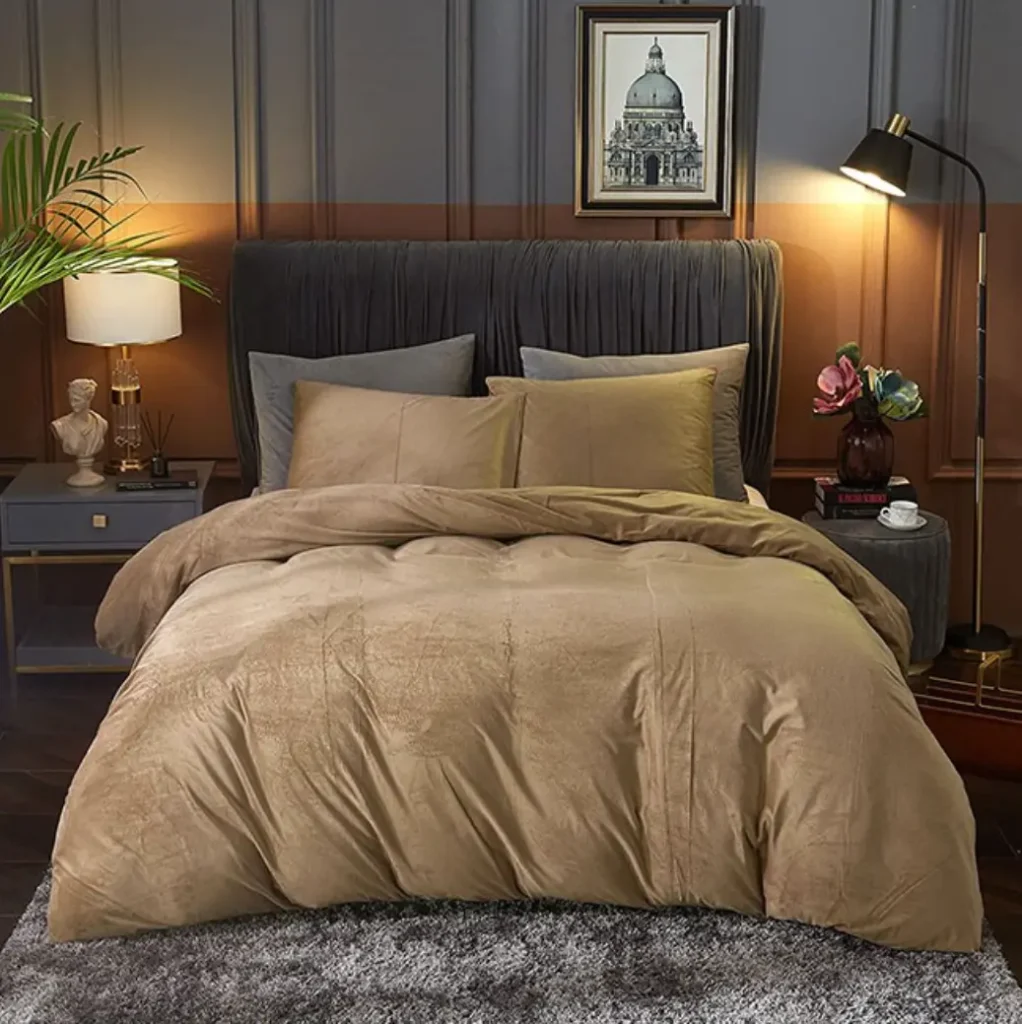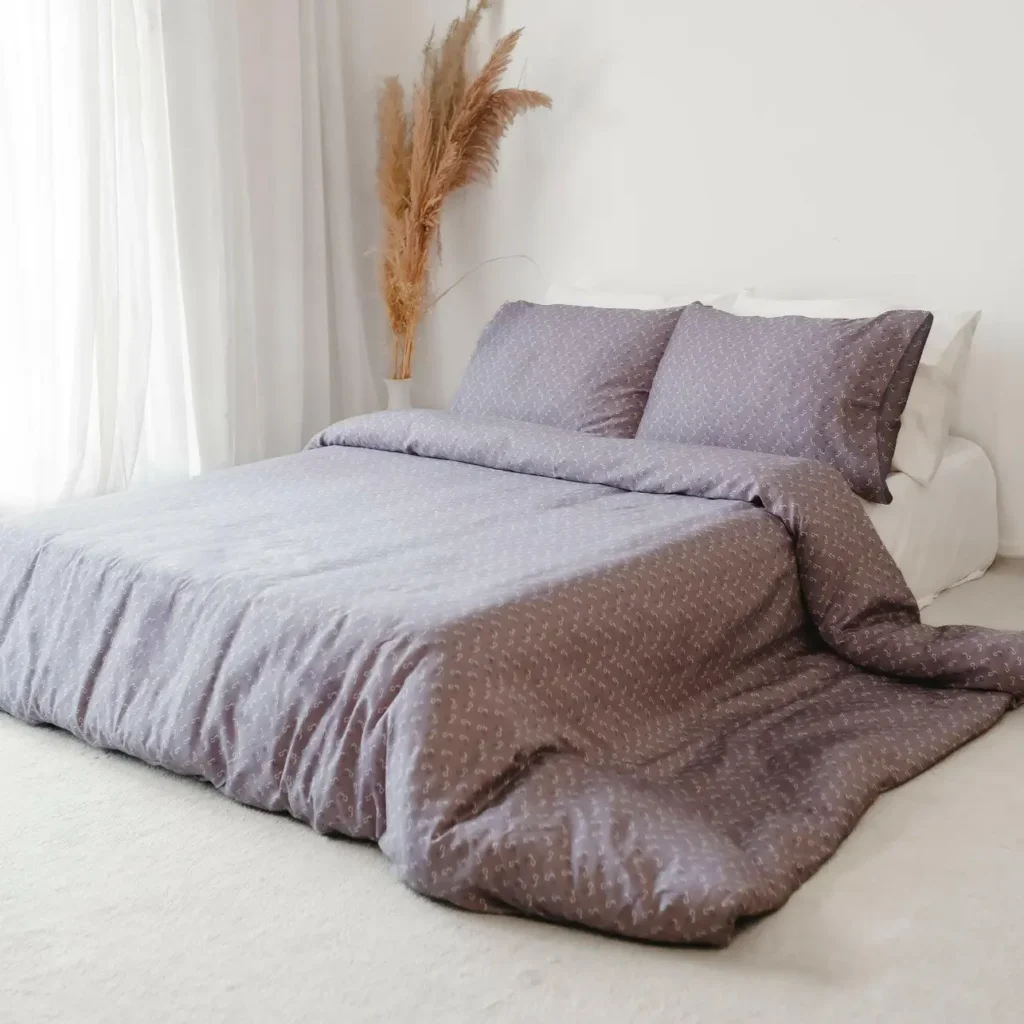Many people have a question that what is a duvet? A duvet is a popular bedding option that provides warmth and comfort, making it a staple in many households around the world. Understanding what a duvet is, how it differs from other bedding items, and its advantages and disadvantages can help you make informed choices for your bedding needs.
1. The Definition of a Duvet
1.1 What Constitutes a Duvet?
A duvet is a type of blanket that is typically filled with down, feathers, or synthetic materials. It is designed to be used as a top layer of bedding, providing insulation and warmth. The outer fabric is usually made from cotton or a cotton blend, which is soft to the touch and breathable.
1.2 The Origin of Duvets
The word “duvet” originates from the French word for “down,” referring to the soft undercoating of birds that is often used in these comforters. The concept of the duvet is believed to have emerged in Europe, specifically in countries like France and Germany, during the 19th century. Since then, it has become a favored choice in many regions around the globe.
If you want some information about What is Calamari then check out our previous blog post.

2. How Duvets Differ from Other Bedding Options
2.1 Duvet vs. Comforter
While both duvets and comforters are used to provide warmth, there are significant differences between them:
- Structure: A duvet is typically a plain cover that requires a cover, whereas a comforter is usually a standalone piece that is often patterned or quilted.
- Care: Duvets can be more easily cleaned, as only the duvet cover usually needs washing. Comforters often require more care due to their bulk and construction.
- Warmth and Insulation: Duvets are known for better insulation properties due to their filling, whereas comforters may be lighter and less effective in colder conditions.
2.2 Duvet vs. Blanket
Duvets differ from traditional blankets in several ways:
- Filling: Duvets are filled with down, feathers, or synthetic materials, while blankets are usually made from a single type of fabric such as wool, cotton, or fleece.
- Warmth: Duvets generally provide more warmth due to their insulation properties, making them suitable for colder climates.
- Usage: Duvets are often used as the primary source of warmth on a bed, while blankets may be layered or used individually.
3. The Structure of a Duvet
3.1 Components of a Duvet
A typical duvet consists of three main components:
- Outer Shell: Made from soft, breathable fabric, the outer shell encases the filling. Cotton is the most common material, but other options like polyester blends are also available.
- Filling: The filling can be made from various materials, including down, feathers, synthetic fibers, or a combination of these. The type of filling affects the duvet’s warmth, weight, and overall feel.
- Baffle Box Design: Many duvets feature a baffle box construction, which involves stitching the fabric into compartments. This design prevents the filling from shifting, ensuring even distribution and maintaining warmth.
3.2 Duvet Covers
A duvet cover is an essential companion to a duvet. It serves several purposes:
- Protection: It protects the duvet from dirt, spills, and wear, prolonging its lifespan.
- Aesthetic Appeal: Duvet covers come in a wide range of colors, patterns, and designs, allowing for easy updates to bedroom decor.
- Ease of Cleaning: The duvet cover can be removed and washed separately, making maintenance simpler.
If you want some information about What is Calamari then check out our previous blog post.
4. Choosing the Right Duvet
4.1 Factors to Consider
When selecting a duvet, several factors should be considered to ensure it meets your needs:
- Fill Type: Down provides superior warmth and lightweight comfort, while synthetic materials can be hypoallergenic and easier to care for. Consider your preferences and any allergies you may have.
- Weight: Duvets come in various weights, from lightweight summer options to heavy winter versions. Choose a weight that matches your climate and personal comfort.
- Thread Count: A higher thread count usually indicates a softer, more durable duvet cover. Aim for a thread count of at least 200 for optimal comfort.
4.2 Size
Duvets are available in multiple sizes, typically corresponding to standard mattress sizes: twin, full, queen, and king. It’s essential to select a duvet that fits your bed properly, as a correctly sized duvet will provide better coverage and warmth.

5. Pros and Cons of Duvets
5.1 Pros
- Versatile Warmth: Duvets offer varying levels of warmth, making them suitable for all seasons. By switching out the covers, you can easily change the aesthetic of your bedding.
- Easy to Maintain: Duvets can be simpler to maintain than comforters. The duvet cover is usually the only item that needs frequent washing.
- Lightweight and Packable: Many duvets are lightweight and can be easily folded for storage, making them ideal for travel or seasonal use.
- Customization: The use of duvet covers allows for personalization. You can easily change the look of your bedding without needing to purchase a new comforter.
- Breathability: Duvets made with natural materials, such as cotton and down, tend to be breathable, promoting a comfortable sleeping environment.
5.2 Cons
- Cost: High-quality duvets, especially those filled with down, can be expensive. Initial investment may be higher than other bedding options.
- Care Requirements: While the covers are easy to wash, some duvet fillings require specific cleaning methods, which can be a hassle.
- Slippage: Duvets can sometimes slip inside their covers, leading to an uneven appearance. This issue can be mitigated with ties or snaps, but it’s still a consideration.
- Allergies: Those with allergies may find that down or feather fillings aggravate their symptoms. Synthetic options can be better in this case, but may not offer the same warmth.
- Storage Needs: Duvets, especially heavier winter versions, may require additional storage space when not in use.
6. How to Care for a Duvet
6.1 Washing
The care instructions for washing a duvet vary depending on the filling material. Generally:
- Duvet Covers: These can typically be washed in a machine on a gentle cycle. Regular washing is recommended to keep them fresh.
- Duvets: Many duvets can be machine washed, but some may require dry cleaning. Always check the care label before washing.
6.2 Drying
Drying it properly is essential to maintain its loft and prevent mold:
- Drying Method: If machine drying, use low heat and add dryer balls to help fluff the filling. Alternatively, air drying is a gentle option, but it requires more time.
6.3 Storage
When not in use, store it in a breathable cotton bag to protect it from dust and moisture. Avoid storing it in a damp area, as this can lead to mildew.

7. Conclusion
In conclusion, it is a versatile bedding option that offers comfort, warmth, and aesthetic flexibility. With its variety of fill types, weights, and cover designs, it can cater to individual preferences and seasonal needs. While there are pros and cons to consider—such as maintenance and cost—many people find that the benefits of using a duvet far outweigh the drawbacks. By understanding the characteristics of duvets and how to care for them, you can create a cozy, inviting sleeping environment that enhances your overall sleep quality. Whether you’re a seasoned duvet user or considering one for the first time, this bedding choice has much to offer in terms of comfort and style.
If you want some information about What is Calamari then check out our previous blog post.


